- Accueil
- Pages cachées
- 11 JANVIER 2024 NEWS
11 JANVIER 2024 NEWS
INSTITUT SUPERIEUR D'ANTHROPOLOGIE
INSTITUT OF ANTHROPOLOGY
COURS ONLINE – COURS A DISTANCE
INSCRIPTIONS OUVERTES
REGISTER NOW
EGYPTE –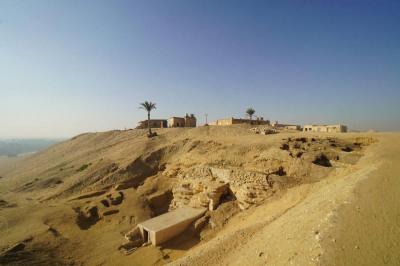
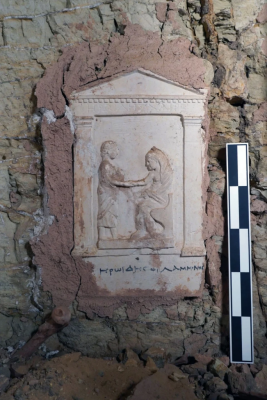 Saqqara - A team of Egyptian and Japanese archaeologists has unveiled a rock-cut tomb believed to be more than 4,000 years old and a myriad of artifacts spanning different historical periods during its current excavation season in Saqqara Necropolis. In a Facebook post, the Ministry of Tourism and Antiquities said: “The joint Egyptian-Japanese archaeological mission between the Supreme Council of Archaeology and Waseda University has succeeded in uncovering a rock tomb from the Second Dynasty, a number of architectural elements, burials and archaeological finds in the Saqara region. “The mission has carried out recording and archaeological documentation of all the archaeological finds found this season. According to Ahram Online, the discoveries include the remains of a human buried with a colored mask and the burial of a small child, both of which are thought to date back to the Second Dynasty. According to experts, the tomb dates from 2649 to 2150 BC. The architectural marvel, thought to date back to the Second Dynasty, has intricate designs and provides insight into the craftsmanship of ancient Egyptian builders. The tomb’s design and the pottery discovered within it are important indicators for understanding its historical context.
Saqqara - A team of Egyptian and Japanese archaeologists has unveiled a rock-cut tomb believed to be more than 4,000 years old and a myriad of artifacts spanning different historical periods during its current excavation season in Saqqara Necropolis. In a Facebook post, the Ministry of Tourism and Antiquities said: “The joint Egyptian-Japanese archaeological mission between the Supreme Council of Archaeology and Waseda University has succeeded in uncovering a rock tomb from the Second Dynasty, a number of architectural elements, burials and archaeological finds in the Saqara region. “The mission has carried out recording and archaeological documentation of all the archaeological finds found this season. According to Ahram Online, the discoveries include the remains of a human buried with a colored mask and the burial of a small child, both of which are thought to date back to the Second Dynasty. According to experts, the tomb dates from 2649 to 2150 BC. The architectural marvel, thought to date back to the Second Dynasty, has intricate designs and provides insight into the craftsmanship of ancient Egyptian builders. The tomb’s design and the pottery discovered within it are important indicators for understanding its historical context.
Archaeologists reveal 4,000-year-old rock-cut tomb, artifacts in Saqqara - Arkeonews
CHINE –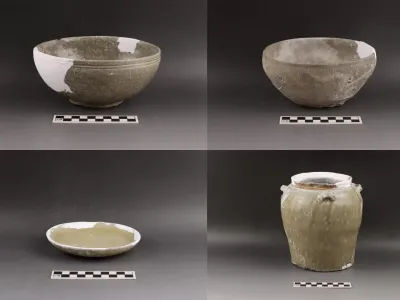 Ningbo - Two archaeological sites were unearthed in the city of Ningbo in east China's Zhejiang Province, offering important clues for the study of social life during the Six Dynasties period (222-589) and the late Liangzhu culture, the municipal institute of cultural and relic management said. This was reported by The Xinhua News Agency. The excavation, which lasted from March to May last year, unveiled two relic sites, namely, the Shuqiao relic site and the Panjiada relic site in the city's Haishu district. Around 450 cultural relics were found during this excavation. The excavated objects include porcelain products, pottery ware, stoneware, woodware and metalware. "A considerable number of similar artifacts were found at the Shuqiao relic site, suggesting the existence of commercial and trade activities", – said Wang Guangyuan, deputy head of the institute. Wang added that the discovery of a waterside wooden structure serving as a wharf or warehouse is a rare archaeological finding related to the Six Dynasties period.
Ningbo - Two archaeological sites were unearthed in the city of Ningbo in east China's Zhejiang Province, offering important clues for the study of social life during the Six Dynasties period (222-589) and the late Liangzhu culture, the municipal institute of cultural and relic management said. This was reported by The Xinhua News Agency. The excavation, which lasted from March to May last year, unveiled two relic sites, namely, the Shuqiao relic site and the Panjiada relic site in the city's Haishu district. Around 450 cultural relics were found during this excavation. The excavated objects include porcelain products, pottery ware, stoneware, woodware and metalware. "A considerable number of similar artifacts were found at the Shuqiao relic site, suggesting the existence of commercial and trade activities", – said Wang Guangyuan, deputy head of the institute. Wang added that the discovery of a waterside wooden structure serving as a wharf or warehouse is a rare archaeological finding related to the Six Dynasties period.
New archaeological sites found in east China | Ukrainian news (ukranews.com)
SUEDE - Lilla Torg - Archaeologists in Sweden have uncovered the remains of a “powerful” and tall medieval man, buried along with his well-preserved 4-foot-long sword, hinting he was part of high nobility during his time. Researchers suspect the 1.90m (6ft 3in) tall man may have been a nobleman who died around 15th or early 16th century when the region was unified with Denmark and Norway. The finding was made during archaeological investigation at Lilla Torg in Halmstad in a grave. The 4-foot-long sword, buried to the left of the man, was the only object found in the 49 graves examined so far during the ongoing reconstruction of Lilla Torg, researchers say. While the preserved parts of the sword’s blade and wooden handle measured at a length of about 1.3 meters on discovery, archaeologists say true total length of the weapon centuries ago is yet to be determined.
GRECE –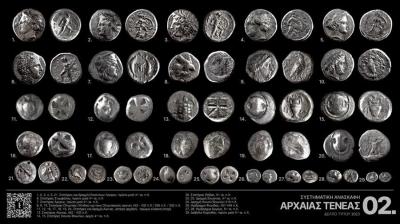

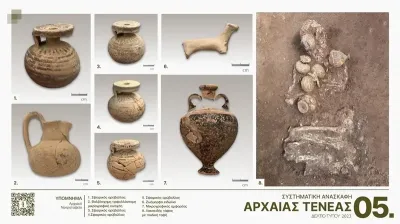 Tenea - Archaeologists in Greece discovered a hoard of rare ancient coins and other treasures at the ruins of Tenea, near Corinth, a city that was built by Trojan prisoners of war. The Ministry of Culture announced on Tuesday that the recent excavation unearthed 29 silver ancient Greek coins dating from the late 6th century. Several are among the rarest and most historic coins of ancient Greece, the ministry says. They include three staters of Elis minted at Olympia during different Olympic Games, staters of Aegina with a land instead of a sea turtle, staters of Stymphalos, Argos and Opuntia Lokron, as well as staters of Thebes from the 5th century BC depicting Hercules suffocating two snakes with his hands. The stater, as a Greek silver currency, first as ingots, and later as coins, circulated from the 8th century BC to AD 50. The earliest known stamped stater (having the mark of some authority in the form of a picture or words) is an electrum turtle coin, struck at Aegina that dates to about 650 BC. The treasure is linked to the finds of cult use (female and animal figurines, miniature vases and others) that were identified last year and continued to be identified this year, giving a clear ritual character to the areas that are revealed the announcement says. The excavations at Tenea also revealed a section of Hadrian’s aqueduct, determining the course of one of the largest hydraulic works of the 2nd century. A.D. in Greece. Also, part of the prehistoric settlement of Tenea, dating to the Early Bronze Age II (2,600 – 2,300 BC), was identified and excavated, confirming the area’s habitation before the fall of Troy. In addition, a rich building complex from the late Archaic times to the Hellenistic times was revealed, with individual areas of cult use between them and three extremely well-maintained tanks, one of them with a descending-ascending scale. The new excavations brought to light dozens of ancient pots and figurines.
Tenea - Archaeologists in Greece discovered a hoard of rare ancient coins and other treasures at the ruins of Tenea, near Corinth, a city that was built by Trojan prisoners of war. The Ministry of Culture announced on Tuesday that the recent excavation unearthed 29 silver ancient Greek coins dating from the late 6th century. Several are among the rarest and most historic coins of ancient Greece, the ministry says. They include three staters of Elis minted at Olympia during different Olympic Games, staters of Aegina with a land instead of a sea turtle, staters of Stymphalos, Argos and Opuntia Lokron, as well as staters of Thebes from the 5th century BC depicting Hercules suffocating two snakes with his hands. The stater, as a Greek silver currency, first as ingots, and later as coins, circulated from the 8th century BC to AD 50. The earliest known stamped stater (having the mark of some authority in the form of a picture or words) is an electrum turtle coin, struck at Aegina that dates to about 650 BC. The treasure is linked to the finds of cult use (female and animal figurines, miniature vases and others) that were identified last year and continued to be identified this year, giving a clear ritual character to the areas that are revealed the announcement says. The excavations at Tenea also revealed a section of Hadrian’s aqueduct, determining the course of one of the largest hydraulic works of the 2nd century. A.D. in Greece. Also, part of the prehistoric settlement of Tenea, dating to the Early Bronze Age II (2,600 – 2,300 BC), was identified and excavated, confirming the area’s habitation before the fall of Troy. In addition, a rich building complex from the late Archaic times to the Hellenistic times was revealed, with individual areas of cult use between them and three extremely well-maintained tanks, one of them with a descending-ascending scale. The new excavations brought to light dozens of ancient pots and figurines.
CHINE -  Chongqing - A tomb that dates back some 2,200 years ago was uncovered inadvertently in Southwest China's Chongqing municipality last year, amazing archaeologists with its extremely well-preserved state and some unique relics that have never been seen before. The archaeologists announced the discoveries during a seminar last month at the Guankou No 1 Tomb of the Western Han Dynasty (206 BC-AD 24), saying that it was the earliest tomb nationwide that can be precisely dated (193 BC) after the dynasty was established. "A clear-water tomb is formed after groundwater seeps through and is filtered by a special type of dirt that was used to seal the tomb, with leftover mud and sand sinking to the bottom of the coffin," Tang Xuefeng, director of Jingmen Museum in Hubei province, explained during a program on China Central Television. A tomb submerged in clear water often indicates that relics inside are well-preserved, as the water could help keep air out and protect the relics from erosion. After pumping out the water, experts found a wooden slip that recorded the precise date of the tomb being sealed, which translates to 193 BC, making it the earliest tomb found after the establishment of the Western Han Dynasty. Some 600 relics were found in the tomb, and most are relatively intact, experts said, adding that some have not been seen elsewhere. For example, a whole set of wooden slips indicating time were uncovered, experts said, saying that it was the nation's first such discovery. In the set of 23 slips, one read "today"; the other 22 each featured a character from the Tiangan-Dizhi system, the ancient Chinese way of recording date and time. In addition, paintings were found on two sides of the inner coffin. The slips in the tomb meant that the paintings were also the earliest in the nation that can be precisely dated. Other attention-grabbing items included a specially ornamented sword sheath, a 2-meter-long spear, a 1.2-meter-long bow, a game board and residue from grain and fruits such as chestnuts, which archaeologists believed was a favorite when the tomb owner was alive. They added that there were some items that needed to be unpacked and further studied.The relics showed characteristics of integration among various cultures as the Western Han Dynasty was gaining a foothold and expanding its influence nationwide, experts said. Archaeologists deduced that with such a large number of buried objects, the owner must have been someone with an eminent status. Through wooden chips dubbed gaodishu — "a letter to the underworld" — that serve as a "reference letter" believed to help the deceased better migrate to the underworld, experts said the tomb owner was likely a high-ranking official in charge of supervising other officials. "The words 'yushichang' were clearly written in the reference letter," excavation team leader Huang told Shangyou News a week after the seminar, citing the latest finding. "We deduced that yushi may refer to the position he served, while chang may be his name." Established during the Qin Dynasty (221-206 BC) and maintained for centuries, yushi was a position set to supervise other high-ranking officials.
Chongqing - A tomb that dates back some 2,200 years ago was uncovered inadvertently in Southwest China's Chongqing municipality last year, amazing archaeologists with its extremely well-preserved state and some unique relics that have never been seen before. The archaeologists announced the discoveries during a seminar last month at the Guankou No 1 Tomb of the Western Han Dynasty (206 BC-AD 24), saying that it was the earliest tomb nationwide that can be precisely dated (193 BC) after the dynasty was established. "A clear-water tomb is formed after groundwater seeps through and is filtered by a special type of dirt that was used to seal the tomb, with leftover mud and sand sinking to the bottom of the coffin," Tang Xuefeng, director of Jingmen Museum in Hubei province, explained during a program on China Central Television. A tomb submerged in clear water often indicates that relics inside are well-preserved, as the water could help keep air out and protect the relics from erosion. After pumping out the water, experts found a wooden slip that recorded the precise date of the tomb being sealed, which translates to 193 BC, making it the earliest tomb found after the establishment of the Western Han Dynasty. Some 600 relics were found in the tomb, and most are relatively intact, experts said, adding that some have not been seen elsewhere. For example, a whole set of wooden slips indicating time were uncovered, experts said, saying that it was the nation's first such discovery. In the set of 23 slips, one read "today"; the other 22 each featured a character from the Tiangan-Dizhi system, the ancient Chinese way of recording date and time. In addition, paintings were found on two sides of the inner coffin. The slips in the tomb meant that the paintings were also the earliest in the nation that can be precisely dated. Other attention-grabbing items included a specially ornamented sword sheath, a 2-meter-long spear, a 1.2-meter-long bow, a game board and residue from grain and fruits such as chestnuts, which archaeologists believed was a favorite when the tomb owner was alive. They added that there were some items that needed to be unpacked and further studied.The relics showed characteristics of integration among various cultures as the Western Han Dynasty was gaining a foothold and expanding its influence nationwide, experts said. Archaeologists deduced that with such a large number of buried objects, the owner must have been someone with an eminent status. Through wooden chips dubbed gaodishu — "a letter to the underworld" — that serve as a "reference letter" believed to help the deceased better migrate to the underworld, experts said the tomb owner was likely a high-ranking official in charge of supervising other officials. "The words 'yushichang' were clearly written in the reference letter," excavation team leader Huang told Shangyou News a week after the seminar, citing the latest finding. "We deduced that yushi may refer to the position he served, while chang may be his name." Established during the Qin Dynasty (221-206 BC) and maintained for centuries, yushi was a position set to supervise other high-ranking officials.
Ancient tomb accidentally revealed in Chongqing - China.org.cn
CHINE - Shaanxi - A graveyard with 285 tombs dating back to as early as the 4th century has been discovered in Shaanxi Province in northwest China, according to the Shaanxi Provincial Cultural Heritage Administration. The tombs, spanning a timeframe from the Sixteen Kingdoms period (304-439) to the Sui and Tang dynasties (581-907), were found in an orderly-aligned layout in the graveyard. The excavation was initiated in 2021. Pottery figurines, pottery stoves and kettles, pottery lanterns, and epitaph bricks imprinted with characters identifying the year the brick was made were unearthed from the tombs. Archaeologists believe the excavation of the graveyard will help shed light on the evolution of the burial and sacrificial system in north China in the Sixteen Kingdoms period and Northern Dynasties (439-581). The discovery will also contribute to studies on population mix and ethnic integration in the Chang'an region, providing insights into the complex historical context, according to the archaeologists.
Tombs dating back to 4th century discovered in China's Shaanxi - China.org.cn
MEXIQUE –  - Archaeologists from the National Institute of Anthropology and History (INAH) conducting salvage work along section 7 of the Maya Train discovered a funerary urn with a carved image of a corn god. According to a press announcement by INAH, the general director of INAH, Diego Prieto Hernández, said that, in terms of its typology, this urn has been identified as a Paaktzatz-style vessel. The funerary urn “presents a very interesting image of the corn god emerging from the leaves of a cob,” Hernández said. According to Prieto Hernández, the urn was found near a similar vessel, which may indicate that the vessels were part of an ancient offering. Due to its typology, the clay pot has been identified as a Paaktzatz-style urn, containing human remains. An anthropomorphic pastillage figure depicting the Maya corn god is seen on the funerary urn, according to a press release, and an owl is depicted on the lid, which is also present on the other vessel. On the front of the vessel is a small anthropomorphic figure made of pastillage (a decorative technique using pieces of ceramic paste), alluding to the deity’s representation as an ear of corn in the growth stage. In addition to the depiction of the corn god, the urn has ornamentation resembling the Mayan symbol “ik,” which represents wind and divine breath. The ornamentation of the second vessel consists of applications on the sides, which simulate the thorns of a ceiba tree, a sacred tree among the Mayans of the past and present. Archaeologists stated that similar images of the Maya deity have been found in figurines from the island of Jaina, in Campeche. During the Classic period of Maya iconography, the owl was considered an omen and a symbol of war. Paaktzatz vessels from the Río Bec region of Campeche, crafted between 680 and 770 A.D., provide evidence of this.
- Archaeologists from the National Institute of Anthropology and History (INAH) conducting salvage work along section 7 of the Maya Train discovered a funerary urn with a carved image of a corn god. According to a press announcement by INAH, the general director of INAH, Diego Prieto Hernández, said that, in terms of its typology, this urn has been identified as a Paaktzatz-style vessel. The funerary urn “presents a very interesting image of the corn god emerging from the leaves of a cob,” Hernández said. According to Prieto Hernández, the urn was found near a similar vessel, which may indicate that the vessels were part of an ancient offering. Due to its typology, the clay pot has been identified as a Paaktzatz-style urn, containing human remains. An anthropomorphic pastillage figure depicting the Maya corn god is seen on the funerary urn, according to a press release, and an owl is depicted on the lid, which is also present on the other vessel. On the front of the vessel is a small anthropomorphic figure made of pastillage (a decorative technique using pieces of ceramic paste), alluding to the deity’s representation as an ear of corn in the growth stage. In addition to the depiction of the corn god, the urn has ornamentation resembling the Mayan symbol “ik,” which represents wind and divine breath. The ornamentation of the second vessel consists of applications on the sides, which simulate the thorns of a ceiba tree, a sacred tree among the Mayans of the past and present. Archaeologists stated that similar images of the Maya deity have been found in figurines from the island of Jaina, in Campeche. During the Classic period of Maya iconography, the owl was considered an omen and a symbol of war. Paaktzatz vessels from the Río Bec region of Campeche, crafted between 680 and 770 A.D., provide evidence of this.
Funerary urn depicting Maya corn god uncovered during Maya Train work - Arkeonews
EGYPTE –  Al Bahnasa - Archaeologists made a ground-breaking discovery of rock-hewn Ptolemaic and Roman tombs, mummies, coffins, golden masks, and terracotta statues in the historic city of Al Bahnasa in the Minya governorate. The Supreme Council of Antiquities’ Secretary-General, Dr. Mustafa Waziri, explained that the discovered Roman-era tombs were located in the eastern part of the Upper Cemetery of El-Bahnasa. These tombs feature a new burial style, directly excavated into the natural rock below the ground. “The new discovery is shedding more light on the rich history of the region, as the team uncovered a series of rock-cut tombs dating back to both the Ptolemaic [305-30 BC] and Roman [30 BC-641 AD] periods, showcasing unique burial practices and artistic expressions of the time,” said Secretary General of the Supreme Council of Antiquities (SCA) Mostafa Waziri. He pointed out that one of the most remarkable findings is the discovery of terracotta statues depicting deity Isis-Aphrodite adorned with foliage crowns, representing a significant addition to the archaeological record. Terracotta figurines representing goddesses such as Isis and Aphrodite with floral crowns were also found for the first time in El-Bahnasa. This suggests that the area still holds many secrets about the funeral rituals of different historical periods
Al Bahnasa - Archaeologists made a ground-breaking discovery of rock-hewn Ptolemaic and Roman tombs, mummies, coffins, golden masks, and terracotta statues in the historic city of Al Bahnasa in the Minya governorate. The Supreme Council of Antiquities’ Secretary-General, Dr. Mustafa Waziri, explained that the discovered Roman-era tombs were located in the eastern part of the Upper Cemetery of El-Bahnasa. These tombs feature a new burial style, directly excavated into the natural rock below the ground. “The new discovery is shedding more light on the rich history of the region, as the team uncovered a series of rock-cut tombs dating back to both the Ptolemaic [305-30 BC] and Roman [30 BC-641 AD] periods, showcasing unique burial practices and artistic expressions of the time,” said Secretary General of the Supreme Council of Antiquities (SCA) Mostafa Waziri. He pointed out that one of the most remarkable findings is the discovery of terracotta statues depicting deity Isis-Aphrodite adorned with foliage crowns, representing a significant addition to the archaeological record. Terracotta figurines representing goddesses such as Isis and Aphrodite with floral crowns were also found for the first time in El-Bahnasa. This suggests that the area still holds many secrets about the funeral rituals of different historical periods
Archaeologists, First-ever Roman-era Tombs Dug Directly into the Rock Uncovered in Al Bahnasa, Egypt - Arkeonews
KAZAKHSTAN - 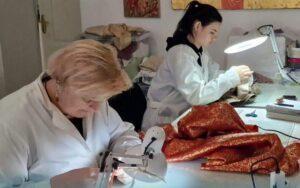 Talmas-Ata - Scientists from the Umai International Laboratory for the Conservation and Restoration of Cultural Heritage at the Margulan Institute of Archaeology took part in the reconstruction of a historical clothing found in the ruins of the mausoleum on the Talmas-Ata necropolis in the Karagandy Region dating back to the Golden Horde era, reported the Ministry of Science and Higher Education on Jan. 10. According to the laboratory manager Tatyana Krupa, the archaeological relics found in the Talmas-Ata mausoleum are unique for the international archaeological community. “Researchers associate the person found in the burial of this mausoleum with family relations with the Bolgan-Ana mausoleum. Chapan (a traditional gown) found there is stored in the laboratory, its conservation has been going on for several years. Last year, at international conferences held at the University of Warsaw (Poland) and the University of Copenhagen (Denmark), my reports were devoted to the study of Golden Horde artifacts on the territory of Kazakhstan and Ukraine. In particular, a separate report in Warsaw was devoted to the chapan found in the Bolgan-Ana mausoleum,” she said. Another unique artifact found among the materials of the Talmas-Ata mausoleum were men’s boots, which became the starting point in creating an image of the person buried in the Talmas-Ata mausoleum. “The work to create an exact copy of ancient boots was carried out using techniques of that time, which we studied for this purpose. We plan to carry out conservation of them over time,” she said. Everything in these boots has been preserved except the heel and sole. On the surviving parts one can see interesting decor, which is very similar to modern Kazakh ornaments. Krupa sees in this the continuity of both technology and clothing traditions of the Golden Horde with the Kazakh dress.
Talmas-Ata - Scientists from the Umai International Laboratory for the Conservation and Restoration of Cultural Heritage at the Margulan Institute of Archaeology took part in the reconstruction of a historical clothing found in the ruins of the mausoleum on the Talmas-Ata necropolis in the Karagandy Region dating back to the Golden Horde era, reported the Ministry of Science and Higher Education on Jan. 10. According to the laboratory manager Tatyana Krupa, the archaeological relics found in the Talmas-Ata mausoleum are unique for the international archaeological community. “Researchers associate the person found in the burial of this mausoleum with family relations with the Bolgan-Ana mausoleum. Chapan (a traditional gown) found there is stored in the laboratory, its conservation has been going on for several years. Last year, at international conferences held at the University of Warsaw (Poland) and the University of Copenhagen (Denmark), my reports were devoted to the study of Golden Horde artifacts on the territory of Kazakhstan and Ukraine. In particular, a separate report in Warsaw was devoted to the chapan found in the Bolgan-Ana mausoleum,” she said. Another unique artifact found among the materials of the Talmas-Ata mausoleum were men’s boots, which became the starting point in creating an image of the person buried in the Talmas-Ata mausoleum. “The work to create an exact copy of ancient boots was carried out using techniques of that time, which we studied for this purpose. We plan to carry out conservation of them over time,” she said. Everything in these boots has been preserved except the heel and sole. On the surviving parts one can see interesting decor, which is very similar to modern Kazakh ornaments. Krupa sees in this the continuity of both technology and clothing traditions of the Golden Horde with the Kazakh dress.
Kazakh Scientists Reconstruct Golden Horde Era Clothing - The Astana Times
INDE –  Ulturu-Kattemane - A hero stone (veera kallu) with an inscription in Kannada script used during 15-16th century has been found at Ulturu-Kattemane, near Gulladi in Kundapur Taluk of Udupi district in Karnataka. The rectangular stone slab, which is about six feet high, contains a sculptural panel at the top. Below this panel is an inscription engraved in four lines. It is written in Kannada script of 15-16th century characters. The inscription opens with an invocation of Lord Ganesh, simply as ‘Shri GaNadhipathaye Namah, Projothpatti Savatsara, Shu 10 lu’ and mentioned that Lavamaaluva and Valeya, a servant (name lost), hatanaage (died). Someone (name lost) erected this hero stone. Be it well (shubhamasthu). The figures depicted in the panel are very interesting. In the centre, a hero is seen standing in veerasana (a certain pose ), raising his right arm with a sword, which is pointed towards the sky. In the left hand, he holds a shield or Guraani. This figure is in royal attire with a kirita (crown) as his head gear. Above this figure, are the moon on right and Sun on the left. On the left of the central figure, a servant is holding an umbrella with a royal insignia. On the right, another servant is seen stabbing himself by his left hand. In the right hand, he holds a shield, Mr. Murugeshi said. “The figures in the panel have very beautifully narrated an event, that a member of a royal family died in an unknown battle. At that time, his servant also died with his master by stabbing himself,” he explained. The hero stone, found outside the fortified village of Gulladi, provides curious inputs of history. Earlier, about eight months ago, a Chikkayi Tayi inscription had been found in the same area. Chikkayi Tayi was an Alupa queen who was married to Hoysala Ballala III. Alupa queens normally resided in their maternal houses, and Gulladi might be the maternal home of Chikkayi Tayi. Lava Alupa was most probably a royal member of Gulladi. After his death, his servant VaLera or VeLevaLi died by stabbing himself. In social stratification, VaLera or VeLevaLi is in servitude status. Therefore, he was probably cremated outside the fortified Gulladi village. Even in Bhuta cult (daiva worship), Bobbarya or Babbu stands in a servitude position only, Mr. Murugeshi said.
Ulturu-Kattemane - A hero stone (veera kallu) with an inscription in Kannada script used during 15-16th century has been found at Ulturu-Kattemane, near Gulladi in Kundapur Taluk of Udupi district in Karnataka. The rectangular stone slab, which is about six feet high, contains a sculptural panel at the top. Below this panel is an inscription engraved in four lines. It is written in Kannada script of 15-16th century characters. The inscription opens with an invocation of Lord Ganesh, simply as ‘Shri GaNadhipathaye Namah, Projothpatti Savatsara, Shu 10 lu’ and mentioned that Lavamaaluva and Valeya, a servant (name lost), hatanaage (died). Someone (name lost) erected this hero stone. Be it well (shubhamasthu). The figures depicted in the panel are very interesting. In the centre, a hero is seen standing in veerasana (a certain pose ), raising his right arm with a sword, which is pointed towards the sky. In the left hand, he holds a shield or Guraani. This figure is in royal attire with a kirita (crown) as his head gear. Above this figure, are the moon on right and Sun on the left. On the left of the central figure, a servant is holding an umbrella with a royal insignia. On the right, another servant is seen stabbing himself by his left hand. In the right hand, he holds a shield, Mr. Murugeshi said. “The figures in the panel have very beautifully narrated an event, that a member of a royal family died in an unknown battle. At that time, his servant also died with his master by stabbing himself,” he explained. The hero stone, found outside the fortified village of Gulladi, provides curious inputs of history. Earlier, about eight months ago, a Chikkayi Tayi inscription had been found in the same area. Chikkayi Tayi was an Alupa queen who was married to Hoysala Ballala III. Alupa queens normally resided in their maternal houses, and Gulladi might be the maternal home of Chikkayi Tayi. Lava Alupa was most probably a royal member of Gulladi. After his death, his servant VaLera or VeLevaLi died by stabbing himself. In social stratification, VaLera or VeLevaLi is in servitude status. Therefore, he was probably cremated outside the fortified Gulladi village. Even in Bhuta cult (daiva worship), Bobbarya or Babbu stands in a servitude position only, Mr. Murugeshi said.
Hero stone from 15th-16th century found near Kundapur - The Hindu Hero stone from 15th-16th century found near Kundapur - The Hindu